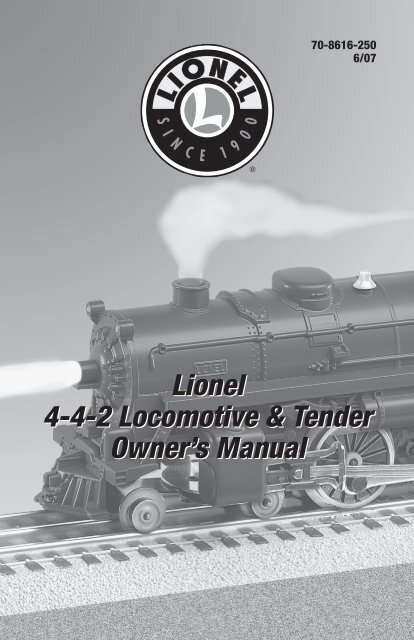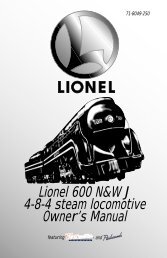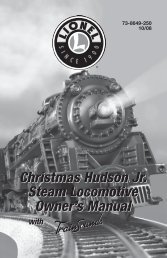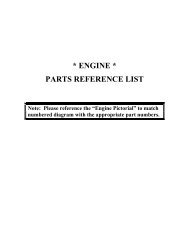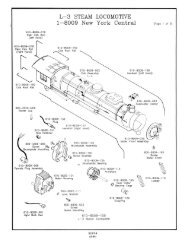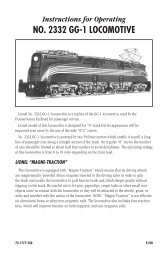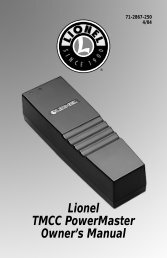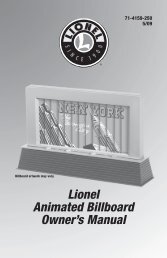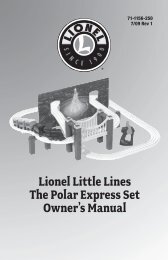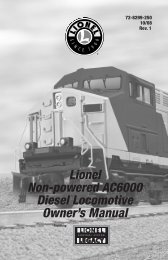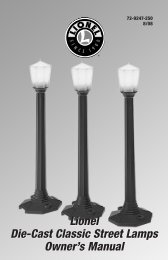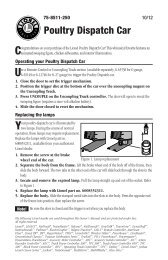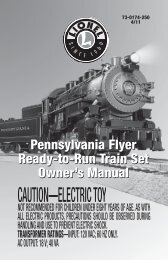Lionel 4-4-2 Locomotive & Tender Owner's Manual Lionel 4-4-2 ...
Lionel 4-4-2 Locomotive & Tender Owner's Manual Lionel 4-4-2 ...
Lionel 4-4-2 Locomotive & Tender Owner's Manual Lionel 4-4-2 ...
Create successful ePaper yourself
Turn your PDF publications into a flip-book with our unique Google optimized e-Paper software.
70-8616-250<br />
6/07<br />
<strong>Lionel</strong><br />
4-4-2 <strong>Locomotive</strong> & <strong>Tender</strong><br />
Owner’s <strong>Manual</strong>
Congratulations<br />
Congradulations on your purchase of the <strong>Lionel</strong> 4-4-2 steam locomotive and tender.<br />
Featuring an air whistle and an operating smoke unit, this locomotive is ready for duty<br />
on your layout.<br />
Features of this locomotive<br />
• Transformer controlled forward, neutral and reverse operation<br />
• Operating headlight<br />
• Operating coupler on rear of tender<br />
• Powerful maintenance-free motor<br />
• Puffing smoke unit<br />
• Air whistle in tender<br />
Table of contents<br />
<strong>Locomotive</strong> operation<br />
Running your locomotive 3<br />
Reverse unit procedure 4<br />
Sounding your locomotive’s whistle 5<br />
Using your locomotive’s magnetic couplers 6<br />
Maintaining and servicing your locomotive<br />
Adding smoke fluid to your locomotive’s smoke generator 7<br />
Replacing your locomotive’s traction tire 8<br />
Lubricating your locomotive 9<br />
Replacing your locomotive’s headlamp 10<br />
Notes 11<br />
Limited Warranty/<strong>Lionel</strong> Service 12<br />
The following <strong>Lionel</strong> marks may be used throughout this instruction manual and are protected under<br />
law. All rights reserved.<br />
<strong>Lionel</strong> ® , TrainMaster ® , Odyssey ® , RailSounds ® , CrewTalk, TowerCom, DynaChuff,<br />
StationSounds, Pullmor ® , ElectroCoupler, Magne-Traction ® , CAB-1 ® Remote Controller,<br />
PowerMaster ® , <strong>Lionel</strong> ZW ® , ZW ® , PowerHouse ® , TMCC ® , <strong>Lionel</strong>ville, Lockon ® , Wireless<br />
Tether, LionMaster ® , FatBoy, American Flyer ® , TrainSounds, PowerMax<br />
The name FasTrack ® is used with permission from Pitsco, Inc.
<strong>Locomotive</strong> operation<br />
Running your locomotive<br />
1<br />
2<br />
With track power off, place your locomotive on the track.<br />
Refer to page 6 for information on coupling the cars.<br />
Connect the drawbar between the locomotive and tender.<br />
See Figure 1.<br />
Caution!<br />
If the smoke unit switch is in the ON position, add smoke fluid to your<br />
locomotive’s stack to prevent damage to the smoke unit. Refer to<br />
page 7 for additional information.<br />
Figure 1. Drawbar connection<br />
3<br />
4<br />
Power up your locomotive with your transformer.<br />
Your locomotive is designed to operate on 7-15 volts alternating<br />
current. Virtually all <strong>Lionel</strong> and <strong>Lionel</strong>-compatible alternating-current<br />
transformers are suitable.<br />
Note!<br />
Move ‘em out!<br />
Do not power your locomotive with direct current (DC) transformers.<br />
The locomotive was designed for use with alternating current (AC)<br />
transformers only.<br />
Get your locomotive moving. Your locomotive goes through a repeating pattern of<br />
operations: forward, neutral, reverse, neutral, and so on. To sequence the reverse unit,<br />
press the DIRECTION button on your transformer, or briefly bring the throttle all the<br />
way back to the OFF position and then forward. Each press of the DIRECTION button<br />
or interruption in track power causes the locomotive to advance to the next operational<br />
state.<br />
Adjust track voltage until your locomotive moves at your desired speed.
<strong>Locomotive</strong> operation<br />
Reverse unit procedure<br />
The electronic reverse unit inside your <strong>Lionel</strong> locomotive acts like the transmission in a car.<br />
When you apply power to the track, the locomotive moves in the direction specified by the<br />
reverse unit—or it sits in neutral, awaiting another power interruption. Power interruptions<br />
are the signal that tells the reverse unit to sequence to the next operational state.<br />
To interrupt power and sequence the locomotive’s reverse unit, press the direction control<br />
button or briefly bring the throttle lever all the way back to the OFF position. The reverse unit<br />
alternates between three states: forward, neutral, and reverse.<br />
Also, the locomotive can be “locked” into a certain mode of operation by throwing the<br />
reverse unit switch located on the underside of the frame (see Figure 2). When the switch<br />
is thrown to the OFF position (towards the rear of the locomotive), the locomotive will be<br />
locked in the next mode of operation in the sequence. To lock your locomotive into a specific<br />
operational state, sequence the locomotive into the desired state and reduce track power<br />
without completely powering down the locomotive, then throw the switch to the OFF position.<br />
The DIRECTION button will then have no effect on the direction of the locomotive. Return the<br />
switch to the ON position to resume forward-neutral-reverse operation.<br />
Additionally, this reverse unit has a “power-up reset” feature. If the locomotive sits without<br />
power for a short period of time, the reverse unit will automatically reset and start in the forward<br />
direction when the transformer is turned on or “powered up,” regardless of the reverse unit<br />
switch position. If the switch is in the OFF position, the locomotive will start in the forward<br />
direction and be “locked” there.<br />
OFF<br />
ON<br />
OFF<br />
ON<br />
Reverse unit on/<br />
off switch<br />
Smoke unit on/off<br />
switch (See page 7)<br />
Figure 2. Switch locations
<strong>Locomotive</strong> operation<br />
Sounding your locomotive’s whistle<br />
Press the HORN/WHISTLE button on your controller to sound the locomotive's whistle. If your<br />
controller does not have a HORN/WHISTLE button, install a <strong>Lionel</strong> Sound Activation Button<br />
(available separately, part no. 610-5906-001). Connect the button as shown in Figure 3.<br />
Note!<br />
All track power must feed through the Sound Activation Button. Do not bypass the<br />
button.<br />
Lock-on<br />
Red wire<br />
1 2<br />
1 2<br />
Existing<br />
wire<br />
Black wire<br />
Common/Ground/U<br />
POWER<br />
SUPPLY<br />
Power/A<br />
<strong>Lionel</strong> no. 610-5906-001<br />
Sound Activation Button for<br />
activating the whistle<br />
Figure 3. Sound Activation Button wiring<br />
The no. 610-5906-001 button works with any <strong>Lionel</strong> AC transformer except<br />
Note!<br />
no. 6-4690 Type MW.
<strong>Locomotive</strong> operation<br />
Using your locomotive’s magnetic couplers<br />
our <strong>Lionel</strong> locomotive’s tender is equipped with an operating magnetic knuckle coupler, a<br />
Y revolutionary design first introduced by <strong>Lionel</strong> in 1945.<br />
<strong>Lionel</strong> magnetic couplers react to the magnetic field generated by a <strong>Lionel</strong> Remote-Control<br />
Track section (available separately, 6-65149 or 6-12746 for O-27 gauge; 6-65530 for O gauge; or<br />
6-12020 for FasTrack layouts).<br />
As illustrated in Figure 4, place your tender’s coupler trigger disc over the central coil of a<br />
Remote-Control Track section and press UNCOUPLE on the controller. The magnetic field pulls the<br />
disc downward, and the knuckle opens.<br />
One operating technique favored by <strong>Lionel</strong> railroaders is the “moving uncouple.” Press the<br />
UNCOUPLE button as the locomotive passes over a Remote-Control Track section. The magnetic<br />
field will open the coupler; the consist remains behind as the locomotive moves on. But be<br />
careful—the speed of a newly uncoupled and moving locomotive can increase dramatically.<br />
Figure 4. Coupler operation
Maintaining and servicing your locomotive<br />
Adding smoke fluid to your locomotive’s smoke generator<br />
our locomotive is equipped with a smoke generator that produces safe, clean, white smoke<br />
Y during operation if the smoke unit switch is in the ON position. Refer to Figure 2 on page<br />
4 for the location of the switch.<br />
The smoke generator requires the periodic addition of <strong>Lionel</strong> smoke fluid in order to<br />
function. Add about four drops of fluid directly into the locomotive’s stack. Smoke production<br />
commences momentarily, faster if you run your locomotive at higher speeds. When smoke<br />
production decreases, add more fluid (about four drops). An idle locomotive will not smoke.<br />
Smoke production is greater at higher voltages and when the locomotive is pulling a heavy<br />
load or a long consist.<br />
Note!<br />
If you prefer to operate the locomotive without smoke or you do not want to add<br />
smoke fluid, slide the smoke unit switch to the OFF position.<br />
Caution!<br />
When the smoke unit switch is in the ON position, always keep a small amount<br />
of smoke fluid in the locomotive’s smoke generator; the generator’s element<br />
can become damaged if operated without smoke fluid. This is particularly true<br />
if your locomotive sits in neutral for an extended period of time without smoke<br />
fluid in the generator.
Maintaining and servicing your locomotive<br />
Replacing your locomotive’s traction tire<br />
One of the locomotive’s drive wheels is fitted with a rubber traction tire to enhance tractive<br />
effort, allowing your locomotive to pull many cars at once.<br />
To replace the traction tire, simply unscrew the drive rod nut from the wheel using a 3/16”<br />
nut driver. Refer to Figure 5. Remove the old traction tire from under the drive rod and slip<br />
on the replacement, <strong>Lionel</strong> part no. 600-0242-206. Replace the spacer, retighten the drive rod<br />
nut, and you’re ready to pull that long freight back to the yard.<br />
Drive rod nut<br />
Spacer<br />
<strong>Lionel</strong> part no. 600-0242-206<br />
Figure 5. Traction tire replacement
Maintaining and servicing your locomotive<br />
Lubricating your locomotive<br />
elp your steam locomotive lead a long and productive life on your railroad by<br />
H maintaining it properly.<br />
We recommend that you purchase a <strong>Lionel</strong> Lubrication and Maintenance Kit (6-62927),<br />
available from your <strong>Lionel</strong> dealer. Two basic rules to keep in mind: never over-lubricate (a<br />
small amount will do) and avoid getting grease or oil on the locomotive’s wheels, contact<br />
rollers, or your track.<br />
You’ll know your locomotive requires lubrication when visual inspection reveals dryness on<br />
the parts indicated in Figure 6. Remove accumulated dirt and dust before lubricating, and<br />
always lubricate any locomotive emerging from prolonged storage.<br />
Lubricate axle ends<br />
with <strong>Lionel</strong> oil<br />
sparingly<br />
Figure 6. Lubrication points<br />
Lubricate gears with<br />
<strong>Lionel</strong> grease sparingly<br />
Lubricate axle ends<br />
with <strong>Lionel</strong> oil<br />
sparingly
Maintaining and servicing your locomotive<br />
Replacing your locomotive’s headlamp<br />
our locomotive is equipped with an LED style headlight for longer life. Please contact your<br />
Y nearest <strong>Lionel</strong> Service Center or <strong>Lionel</strong> Service if this needs replacing.<br />
10
Notes<br />
11
Limited Warranty/<strong>Lionel</strong> Service<br />
This <strong>Lionel</strong> product, including all mechanical and electrical components, moving parts, motors and<br />
structural components, except for light bulbs, is warranted to the original consumer-purchaser, for one<br />
year against original defects in materials or workmanship when purchased through an authorized <strong>Lionel</strong><br />
merchant.<br />
This warranty does NOT cover normal wear and tear, light bulbs, defects appearing in the course of commercial<br />
use, or damage resulting from abuse or misuse of the product by the purchaser. Transfer of this product<br />
by the original consumer-purchaser to another person voids this warranty. Modification of this product<br />
voids this warranty.<br />
Any warranted product which is defective in original materials or workmanship and is delivered by the<br />
original consumer-purchaser to <strong>Lionel</strong> L.L.C. or an authorized <strong>Lionel</strong> L.L.C. Service Center, together with proof<br />
of original purchase will, at the option of <strong>Lionel</strong> L.L.C., be repaired or replaced, without charge for parts or<br />
labor. In the event the defective product cannot be repaired, and a replacement is not available, a refund of the<br />
original purchase price will be granted. Any products on which warranty service is sought must be sent freight<br />
or postage prepaid, as transportation and shipping charges are not covered by the warranty.<br />
In no event shall <strong>Lionel</strong> L.L.C. be liable for incidental or consequential damages.<br />
Some states do not allow the exclusion or limitation of incidental or consequential damages, so the above<br />
exclusion may not apply to you.<br />
This limited warranty gives you specific legal rights, and you may have other rights which vary from state<br />
to state.<br />
Instructions for Obtaining Service<br />
If service for this <strong>Lionel</strong> L.L.C. product is required, bring the item, along with your dated sales receipt and<br />
completed warranty information to the nearest Authorized <strong>Lionel</strong> Service Center. Your nearest <strong>Lionel</strong> Service<br />
Center can be found by calling 1-800-4-<strong>Lionel</strong>, or by accessing our Website at www.lionel.com.<br />
If you prefer to send your product back to <strong>Lionel</strong> L.L.C. for repair in Michigan, you must first call<br />
586-949-4100 or FAX 586-949-5429, or write to Customer Service, P.O. Box 748, New Baltimore, MI<br />
48047-0748, stating what the item is, when it was purchased and what seems to be the problem. You will be<br />
sent a return authorization letter and label to ensure your merchandise will be properly handled upon receipt.<br />
Once you have received your return authorization and label, make sure that the item is packed to prevent<br />
damage during shipping and handling. We suggest that you use the product’s original packaging. This shipment<br />
must be prepaid and we recommend that it be insured.<br />
Please make sure you have followed all of the above instructions carefully before returning any merchandise<br />
for service. You may choose to have your product repaired by one of our Authorized <strong>Lionel</strong> Service Centers<br />
after its warranty has expired. A reasonable service fee will be charged.<br />
Warranty Information<br />
Please complete the information below and keep it, along with your dated sales receipt. You must present<br />
this and your dated sales receipt when requesting warranty service.<br />
Name<br />
Address<br />
Place of Purchase <br />
Date of Purchase<br />
Product Number<br />
Product Description<br />
©2007 LIONEL L.L.C., CHESTERFIELD, MI 48051-2493<br />
UNITED STATES OF AMERICA<br />
PRINTED IN CHINA


